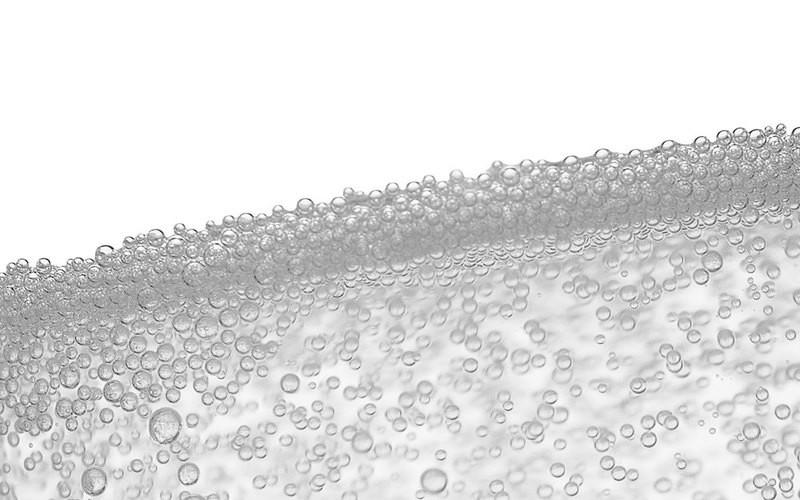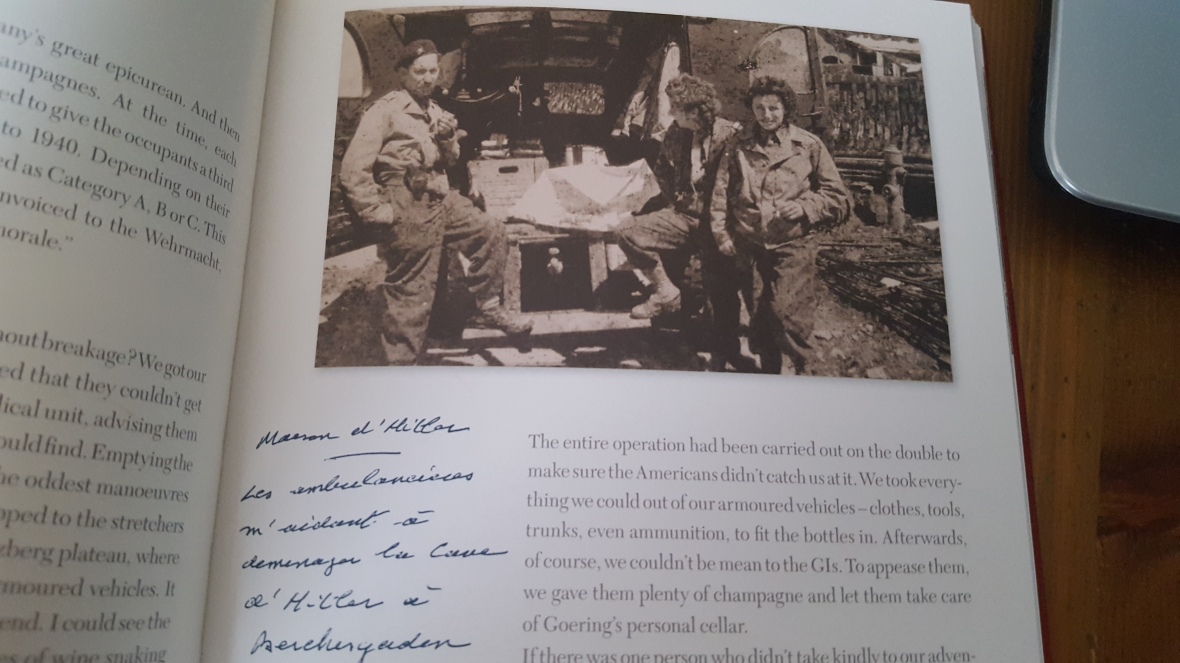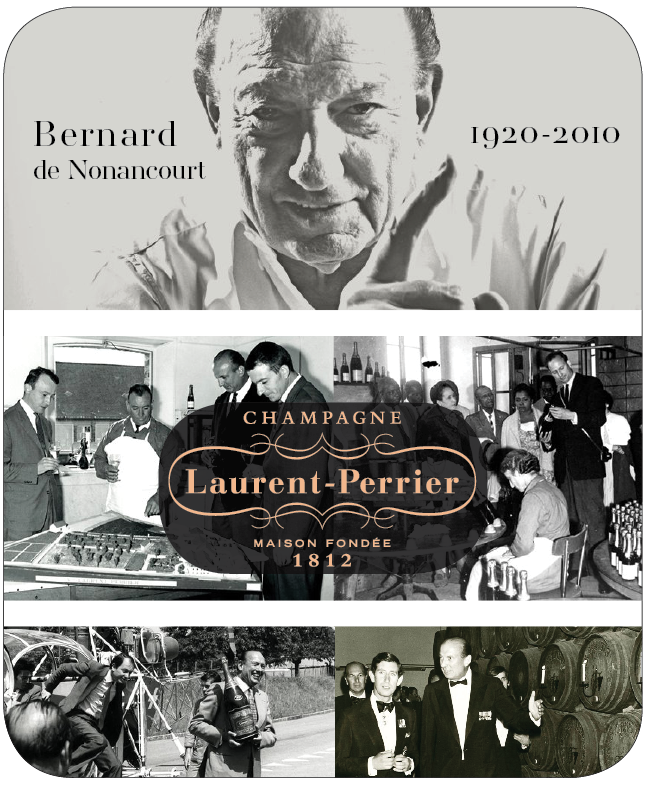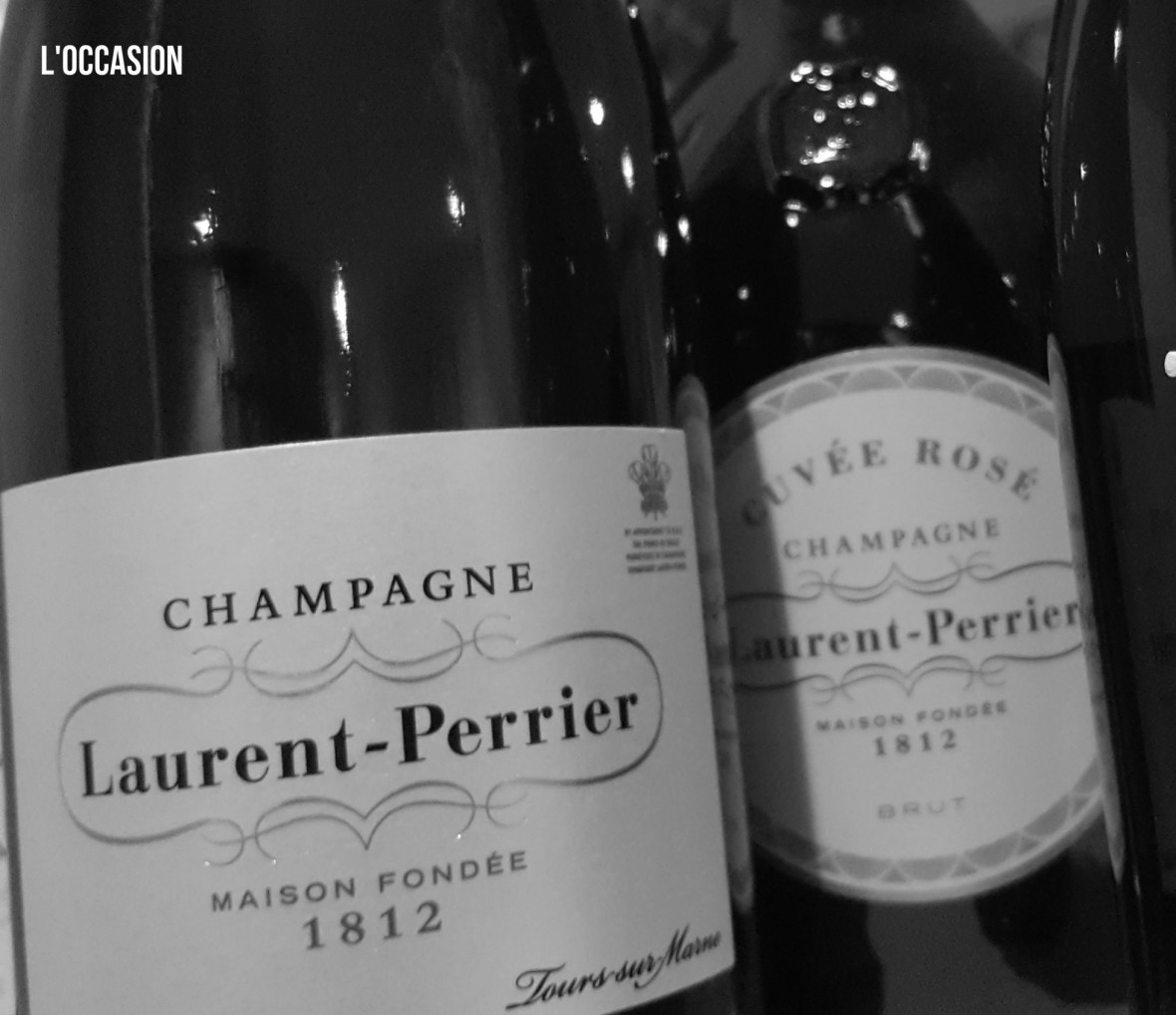
Twelve years ago I wrote a fictional story about a vigneron named Emmeline, raising her daughter in wartime Provence. This character was based purely on imagination, written in my basement office during my maternity leave to care for my middle child. The story was subsequently published initiated a sense of intense need to keep going, to make the story into something bigger.
Readers of L’occasion know that this was the start of everything you see before you, my writing career, my blog, my wine education and my travels…all on behalf of telling Emmeline’s story, which eventually turned into my novel Que Faire?.
During work on the novel I bought the book Wine and War: The French, the Nazis, and the Battle for France’s Greatest Treasure by Don and Petie Kladstrup. It was my first introduction to Bernard de Nonancourt, Champenoise legend and head of Champagne Laurent-Perrier. As a young man de Nonancourt was a French resistance fighter and subsequent member of the French tank regiment that entered into Hitler’s Eagle’s Nest days after his death.
I recently had the opportunity to connect with the US representatives of Laurent-Perrier and when they heard that I was writing about French vignerons in resistance work, they sent me a book written by the family of Bernard de Nonancourt, a biography of his life. While I claim no authorship of the his history, I find it incredibly fascinating and I’d like to share some rich details with you today.
Champagne Laurent-Perrier
The Laurent-Perrier cellars are located in Tours-sur-Marne, a Grand Cru village, framed by Montagne de Reims, the Vallée de la Marne and the Côte des Blancs. According to the history of the house, “The House of Laurent-Perrier was founded in 1812 by André Michel Pierlot and took the name Vve Laurent-Perrier when Mathilde Emilie Perrier, the widow of Eugène Laurent, combined the two family names after she decided to expand the business. Eugénie Hortense Laurent, her daughter, inherited the House in 1925 and sold it to Marie-Louise Lanson de Nonancourt in 1939.
During WWII, Marie-Louise Lanson de Nonancourt ran the business while two of her sons, Maurice and Bernard, joined the French Resistance. In 1945, Bernard de Nonancourt began an exacting apprenticeship, learning every aspect of winemaking from vine to cellar, before his appointment in October 1948 as Chairman and Chief Executive. At that point, the House was employing around 20 people and shipping 80,000 bottles a year.”

Bernard de Nonancourt, courtesy of Laurent-Perrier
Bernard de Nonancourt: Prince of Champagne
In 1942, Bernard was working in the family business when he and his brother Maurice witnessed 15 German trucks, loaded with armed soldiers working under Goering, fill with cases of pillaged Champagne. At this same time, Nazi propaganda illustrated cases of Champagne as incendiary weapons, designed by French ‘terrorists’. The atmosphere grew more intense as German collaborators opposed Bernard’s allegiance to Charles de Gaulle.
Maurice, a pilot, was inspired to take action. He headed to Spain to join de Gaulle’s resistance. He was quickly captured by the Gestapo and detained in Oranienburg-Sachsenhausen prison (viewed as a template for Nazi extermination and work camps) where he fell ill. He never returned from the camp; Bernard eventually heard that his brother had been murdered in a gas chamber with other sick prisoners.
A month after Maurice left, Bernard received an order submit to labor obligations in Germany. To avoid this, Bernard accepted help from a connection whose home was near the demarcation line and this invitation began a series of challenges, starting with losing his clothing and money in a river crossing. Eventually Bernard received a maquis code name and papers and after some time he was assigned to recruitment task in a mountain sport camp for young people. After this he lived for a time, with very little food and gear, in connection with a group in the Alps, in receipt of parachute drops filled with arms and some luxury items, such as chocolate and cigarettes. Burning to see more action, Bernard eventually trained in weapons and plastic explosives and recalls, “That was how we were able carry out more operations, blowing up railway lines, and in particular the line to Valence, dynamiting bridges and the Grenoble artillery reserve. We sabotaged enemy convoys by pouring a sort of glucose into their petrol tanks.”
Around this time, Bernard came in need of guidance. He’d painfully witnessed outside influences (various Communist fighters from assorted backgrounds) burn the homes of French peasants seen as French collaborators (this in a time when the French government has been seen to abandon the needs of it’s people) and this made him quite uncomfortable. He turned to a mystic named Marthe Robin who urged him to return home, but Bernard was wanted by the Gestapo and insisted that his work was with the resistance, despite the infighting and the notes of distrust among Communist-influenced groups.
While Bernard was home, still on the Gestapo hit list, his family took in a German Jew and British parachutist, all while hosting a billeted German officer under the same roof! After a few months of being home, Bernard had joined the local resistance group, passing information and intelligence until the landings on Normandy took place.
A Tank Commander
Bernard’s life of service, however, hadn’t expired. After Normandy, he traveled to Paris to join an armored tank regiment in the French army under General Leclerc. Still waiting to avenge his brother’s death, Bernard offered his Lieutenant 100 bottles of Champagne to “satisfy [his] desire to fight in a tank”. He was placed in a 76-2 as a sniper and the joke was that he paid “100 bottles of Champagne to get [himself] killed.” During this period Bernard was included in the outfit that liberated Dachau concentration camp, of which he recalls, “We had smelled the stench, seen the horror, the corpses, and also the skeletal survivors, chained to barrels and if they were dogs. I thought that perhaps my brother had been subjected to that.”
Lieutenant Galley on Bernard: “Given Nonancourt’s human and military qualities – everybody trusted him – I chose him to be a tank commander in the Alsace and German campaigns. He was a great beanpole of a man, who smiled a lot. He exuded grit and goodwill, was dedicated and very witty. He was part of the second section, which was the first the first to into Berchtesgaden…”
Here is where I ask you to think back, to a young Nonancourt and his brother Maurice, working the the family business as they watched hundreds of cases of local Champagne confiscated for German use.
Berchtesgaden is the site of Hitler’s Eagle’s Nest, set at 1,834 meters above sea level in the Bavarian Alps on the top of the Kehlstein. A 124 meter tunnel had been chiseled out of the mountain and at the end of the tunnel was an elevator that rose to Eagle’s Nest, a place where “gilded doors and interior were made of solid bronze, and it contained padded armchairs and a batter of telephones”. It is noted that color film footage taken by Ava Braun shows Goering and other Nazi high-ups enjoying the property, while immense and immeasurable suffering was experienced by the world, including Bernard’s own brother Maurice.
On May 4th, several days of Hitler’s death, Bernard spent a night in unsettled rest and preparation for the next day. He was instructed to choose “souvenirs” from Hitler’s belongings. Of the box of items he collect, Nonancourt says “I have too many German business friends to bring this collection out without feeling uncomfortable. I’ve never been able to show it off.”

From Nonancourt, Prince of Champagne. “ambulance drivers helping me to empty Hitler’s cellar at Berchtesgaden” – book courtesy Laurent-Perrier
The Liberation of the Cellar
“But the real treasure,” says Nonancourt, “was in the underground areas. The Berchtesgaden mountains were riddled with an incredible network of tunnels. The lieutenant having told me that, being from Champagne, I was the right man to take care of Hitler’s cellar, and it was no sooner said than done. I blew up one armored door, then a second. Once inside you couldn’t see a thing. When I switched my flashlight on, I saw row upon row of metal racks alternating with piles of wooded cases – you wouldn’t believe how many there were! Masses of them! Tens of thousands of bottles and magnums of the greatest Bordeaux wines…there were also Cognacs from the previous century, and Mumm, Pommery and Lanson (Bernard’s family business) Champagnes.” In order to remove all of the wine from the underground cellars, ambulance stretchers had to be employed because the elevator was not working.
“Standing in my turret, I took delivery of the first stretcher party. ‘Time to fill up!’ The lads handed me a case: It was Salon 1928 – the same vintage that was stolen from us at the start of the war!”
At the age of 28, Bernard de Nonancourt returned to a Champagne house life. His brother Maurice had been in line to manage Laurent-Perrier, and with the loss of his expertise, Bernard stepped in to replace him. Bernard died on Friday, October 29th, 2010, peacefully with his family, including his two daughters Alexandra and Stéphanie… more stories to tell about his years at the helm of one of the world’s most exquisite Champagne houses.

Courtesy: Laurent-Perrier
Laurent-Perrier Wines to Try
Cuvée Rosé Laurent-Perrier: “La Cuvée Rosé was created in 1968 from the boldness and know-how of the House of Laurent-Perrier. Perfected at each stage of its making, Cuvée Rosé is acknowledged for its consistency and its high quality. It is characterized by its ripe red fruit aromas, a high intensity and great freshness.” – from the house.
Brut: “Only the best grapes are used for this champagne. Grape varietals: Chardonnay, Pinot Noir, Meunier. Reserve wines up to 20% to ensure perfect consistency in style. Crus: more than 55 crus selected by Laurent-Perrier. The Brut Laurent-Perrier benefits from an ideal ageing time our cellars: 3 years minimum for a 75cl bottle and 4 to 5 years for a magnum. Its balance and freshness are enhanced by a light dosage. 50% of Chardonnay, nearly double the average in Champagne, gives an unique personality to this brut champagne. A very long ageing process in our cellars ensures the wines reach maturity.” -from the house.

French #Winophiles 2017 Champagne Exploration
Join us, Saturday, March 18th 2017 at 10:00 am central on twitter under the hashtag #Winophiles to experience our uncovering of many treasure of Champagne. Everyone is welcome!
To a Winophile, Champagne is…
…crafted uniquely, from start to finish, as Lynn from Savor the Harvest reveals in her post, French #Winophiles Explore Champagne From Beginning to Bubbly Finish.
…dynamic and constantly refreshed, as Jane from Always Ravenous examines in her story, The Evolving Culture of Champagne .
…always enchanting, unfailingly attractive. Lauren from The Swirling Dervish writes about The Enduring Allure of Champagne.
…consistent and timelessly refined. Camilla from Culinary Adventures of Camilla shares a special perspective in her piece, Toasting Seventeen Years with Moët & Chandon Impérial Brut Champagne.
…personal and skilled, as we will learn in the story of Women in Wine: Floriane Eznack, Cellar Master, Champagne Jacquart from Gwendolyn at Wine Predator.
…food-friendly, approachable and versatile, as we’ll learn from Jeff at FoodWineClick! in his story Everyday Celebration with Champagne and Curried Shrimp Salad.
…affordable and surprisingly accessible, revealed as Martin from ENOFYLZ Wine Blog answers the question Under $30 Vintage Champagne? Oui!
…worth fighting for, as we’ve learned from the story of Bernard de Nonancourt of Laurent-Perrier: Champagne Résistance Fighter.
I am always grateful to those that let me retell their story. I understand the intense personal nature of much of this information, which I’ve summarized for this post in the hopes of having the privilege of revising the lives of this family in depth. Thank you to Laurent-Perrier for support, samples and the book.


Loved this story – especially since LP is one of my favorites, but also for the family’s heroics during the war. Just curious – was Marie-Louise Lanson de Nonancourt originally from the Lanson family of Champagne fame?
LikeLiked by 1 person
Yes, indeed! She bought LP because there were so many family members in the Lanson house… she wanted to have something to position for her children. There is so much to tell, and I’ve focused on such a tiny fraction because I’ve educated myself on wartime (WW2) wine, but I hope to get into this story more deeply. Thanks for your comment!
LikeLiked by 1 person
Champagne indeed has a rich history filled with so many stories. Thank you for sharing this one.
LikeLike
Hi Jane! Glad you could join us this month. Champagne is truly a diamond when it comes to preservation and tradition. I’m glad I could carve out this story for us. Thank you!
LikeLike
What a great story, they lived through challenging times!
LikeLike
Hi Jeff — I was just telling my son about another wartime book (The Hiding Place, which I recommend) where a woman walked away from a concentration camp. As you can imagine she was in scraps, hungry and scared. In the book she describes coming upon a hospital and getting aid inside and eventually, a hot bath. Every time I take a hot bath I have a memory of how this woman (Corrie Ten Boom) described this luxury. You are so right about challenging times, and we have our little and big pleasures to remind us how blessed we are… Thanks for hosting our chat this week!
LikeLike
I am propelled to not only buy War and Wine now, but also your book Jill! Both sound like fascinating stories, thanks for sharing your Champagne!
LikeLike
Hi Lynn — So glad you joined us this month and hope to have you continue to Winophile! Thanks for reading and commenting!
LikeLike
Amazing story! Thanks for the thumbnail! I will never look at a bottle of this Champagne the same way!
LikeLike
Hi Gwen! Winemaking is never easy, but this is really incredible!
Thanks for your comment and for reading!
LikeLike
Reblogged this on dandycannes.
LikeLike
Thank you!
LikeLiked by 1 person
My pleasure!
LikeLike
Thanks for sharing this story Jill. I’m a bit of a WWII buff and the stories of sacrifice and bravery never cease to amaze me. Of course we mostly here about it from the American perspective, but my visit to Italy last year and my visit to Champagne a few years brought to light the horrors of war where it was found (thankfully not in the US). Of course today Champagne thrives is perceived as all glitz, but I recall the ‘Blood Vintage” in Champagne and when I visited the Cathedral in Reim saw some of the horrors of war visited upon the people of Champagne. It adds a context that makes me champagne even more!
LikeLike
Hi Martin — I’ve really enjoyed your posts about your trip to Champagne. It seems you had an immersive experience and I’m so glad you share it with us. I always think that for every person like de Nonancourt, there were hundreds (thousands) that didn’t get to make their destiny a reality due to wartime loss. In fact, the book tells about several people who felt compelled to submit to work orders or the like in order to protect family members. I try to remember all the daily stories that aren’t being told. Thanks for your comment!
LikeLiked by 1 person
What a great story! Thank you for sharing it. The stories of Champagne and all of France during WWII never cease to amazing. After visiting the region and in particular Reims it gives a historical context to Champagne that makes it even more special.
LikeLike
Champagne is such a unique spot, they way the manage winemaking and the wine business has a structure unlike anywhere else. How wonderful that you were able to visit. It is so true that we take a piece of each trip home with us. Thank for your comment and for reading along!
LikeLiked by 1 person
Great post. I read Wine & War as well very interested book and Bernard’s and his family’s story, like all of the others, were amazing. Thanks
LikeLike
Thank you for your comment — it is really fascinating, right? I’m always stunned to remember what people experience during wartime!
LikeLiked by 1 person
Agree! Not just what they experience, but also how they survive.
LikeLiked by 1 person
Laurent- Perrier is one of my favorite Champagnes. In fact, I had several glasses recently in Bordeaux and London. Their story featured prominently in Wine and War.
LikeLiked by 1 person
Celebrate with Laurent-Perrier!
LikeLiked by 1 person
This is fascinating! Now I need to read your book, and research this more. I’m always stunned at the level of creativity and perseverance that the French Resistance exhibited, particularly when faced with some of the not so nice facts of war and behaviors we would like to forget.
Thanks for posting!.
LikeLiked by 1 person
Thanks for your comment!
LikeLike
Nice! I am not the biggest fan of Laurent Perrier, but their history sounds very intriguing. No wonder that there are estates who still find caches of hidden champagne from time to time.
LikeLiked by 1 person